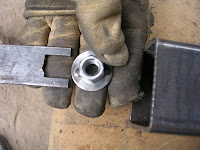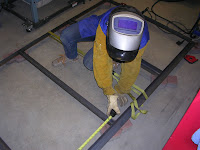EXTREME ADVANCED BEGINNER: A person who is competent in pursuing an activity, and will go all out, but is not considered an expert. I identify myself as an extreme advanced beginner. The idea came from living in a community where many people are "world class" at what they do. Since I'm only proficient, albeit at a variety of things, I started using the term to describe myself. Enjoy these musings about my projects and preoccupations.
Friday, September 30, 2011
Thursday, September 29, 2011
Art Tables: Attaching the Tops
Attaching the MDF tops was easy. I had already cut the MDF to size, rounded over the edges with the router, and put multiple layers of polyurethane coating on both the top and underside.
 I moved the upside down tops onto 6 stools each and hoisted the frames onto them. Centering, drilling and screwing down the frames went quickly. Unfortunately I did it late Sunday afternoon. There were many hours still left to assemble the tables completely. I had hoped to have the tables ready for class monday morning, but as it turned out, we used them without the lower shelves for the first few days.
I moved the upside down tops onto 6 stools each and hoisted the frames onto them. Centering, drilling and screwing down the frames went quickly. Unfortunately I did it late Sunday afternoon. There were many hours still left to assemble the tables completely. I had hoped to have the tables ready for class monday morning, but as it turned out, we used them without the lower shelves for the first few days.The school drills lacked power, so the "high torque" made it possible to actually drive the screw with a pilot hole.
Wednesday, September 28, 2011
Art Tables: The Shelves
I finally decided to use expanded metal as the shelf material. I like the industrial feel, and that the edges won't get wrecked by student's feet. I tack welded each wire end beneath the angle stock then added 2 braces about 24" apart.
Tuesday, September 27, 2011
Art Tables: Building the legs
 After drilling the over sized holes, I cut notches on opposite sides to accommodate welding the nut/washer units to the inside of the leg. I made a "wrench" out of 1" bar stock that would reach the distance to the shelf hole.
After drilling the over sized holes, I cut notches on opposite sides to accommodate welding the nut/washer units to the inside of the leg. I made a "wrench" out of 1" bar stock that would reach the distance to the shelf hole. 
 Holding the nut/washer in place, I was able to use the bridge fixture I welded from 3/4" bar stock to draw the washer flush to the inside of the leg. Centering and tightening the bolt, enabled the nut/washer to stay securely in place while I tack welded the parts together. It took some experimenting with the heat and the technique in order to find the balance of penetration without melting the washer.
Holding the nut/washer in place, I was able to use the bridge fixture I welded from 3/4" bar stock to draw the washer flush to the inside of the leg. Centering and tightening the bolt, enabled the nut/washer to stay securely in place while I tack welded the parts together. It took some experimenting with the heat and the technique in order to find the balance of penetration without melting the washer. Once I got the hang of it and got over the stress of if the process would work or not, it went quickly.
Sunday, September 25, 2011
Art Tables: Tack Welding Nuts & Washers
During the design process, I toyed with different ideas to attach the legs and frames. Because of the size of the tables, it was important to be able to disassemble them for movability. I finally decided on adhering the nuts to the inside of the legs. This would eliminate creating wrench access for assembling.
One of hardest processes to get right was tack welding the nuts to the washers. They had to be centered; the perfect heat was essential; and holding them flat while welding the second side took some experimentation. In the end I only wrecked 5 out of 64.
One of hardest processes to get right was tack welding the nuts to the washers. They had to be centered; the perfect heat was essential; and holding them flat while welding the second side took some experimentation. In the end I only wrecked 5 out of 64.
Saturday, September 24, 2011
Friday, September 23, 2011
Art Tables: Welding Video
Listen to the bacon sizzle! That sounds like a good weld.
Thursday, September 22, 2011
Tuesday, September 20, 2011
Art Tables: Starting to Weld
 |
| Tack welding |
Finally I had to start welding. I took a welding class at the community college several years ago, but this was my first real project. For the first step I tack welded the mitered corners of the top frame. With the corners just tacked, I could square up the frame before solidly welding the seams.
 |
| Squaring the frame |
Next I measured diagonally corner to corner. There was enough flexibility in the system to nudge the frame. By making sure the hypotenuses were equal, it insured that the right triangles that make up the rectangular frame were square (I'm a middle school teacher, so I have to slip in some real world math application).
Monday, September 19, 2011
Art Tables: Hours of Drilling
I spent hours drilling holes that would later be used to bolt the legs to the frames. To create a large enough hole for the 3/8" bolts it took 3 passes graduating from a small bullet drill, to a mid size twist bit, then up to the final over sized hole, for a little wiggle room. Lowering the drill speed helped eliminate overheating.
For the upper frame I drilled a series of small holes every foot to eventually attach the MDF table top. These went quickly with one pass only.
The drill press clamp is incredible! It bolts to the plate allowing for micro adjustments and stability. It facilitated accurate, consistent holes.
For the upper frame I drilled a series of small holes every foot to eventually attach the MDF table top. These went quickly with one pass only.
The drill press clamp is incredible! It bolts to the plate allowing for micro adjustments and stability. It facilitated accurate, consistent holes.
Sunday, September 18, 2011
Subscribe to:
Comments (Atom)












